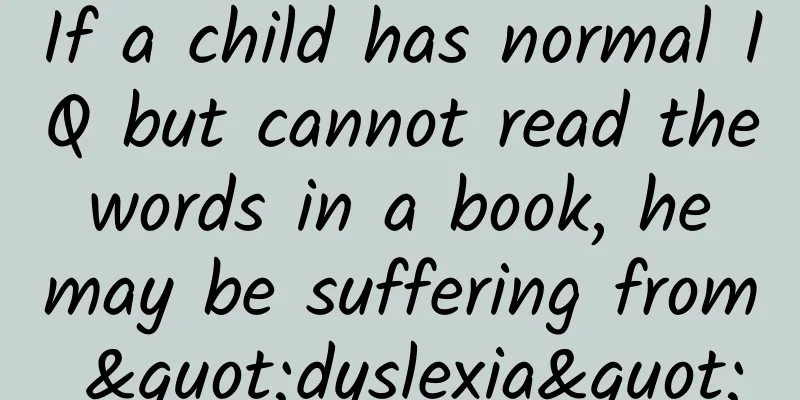If a child has normal IQ but cannot read the words in a book, he may be suffering from "dyslexia"

|
They have normal vision and normal minds, but they seem to face insurmountable difficulties in reading very simple words and sentences... They are not stupid children, they just "really have a hard time reading" >> Written by reporter Duan Ran, edited by Liu Zhao New Media Editor/Li Yunfeng Interview experts: Zhang Wei (Professor, School of Psychology, Central China Normal University) Are there such children around you? Their intelligence level is exactly the same as that of ordinary children. They have normal joys, sorrows, anger, and fears, and have a strong curiosity about everything. At the age of enlightenment, they go to school and receive education like children of the same age. However, once they enter the classroom and start reading and writing, they feel like they are trapped in prison. No matter how hard they study, they cannot fully understand a passage of text or write a Chinese character neatly. Their grades are often lagging behind. Teachers, classmates and parents who are puzzled by this often use crude words such as "not serious", "absent-minded" and even "stupid" to describe their condition. From a scientific point of view, their condition, which is difficult for ordinary people to understand, actually points to a disease that has just begun to be recognized by the Chinese people - dyslexia. (Image source/Scientific Animations) ▼ ▼ ▼ Dyslexia: The mysterious yet common "third group of people" "When I was a kid, I had a hard time reading. I don't know why, but I often read the words upside down and the order of sentences was messed up." Mr. Li from Dalian described his painful learning experience to reporters. Like other children of his age, Mr. Li has a normal mind and a strong desire for knowledge, but once he enters the classroom and picks up the book and sees the words, he always falls into a helpless dilemma: no matter how hard he practices, in his eyes, those rigorous and regular words are like heavenly books, unpredictable and difficult to understand. This inexplicable state, like a haze, has always shrouded Mr. Li's path to study. "In class, I am most afraid of the teacher calling on me to read the text. I almost want to die. I feel like going to school is like going to the grave." Recalling the pain, Mr. Li said self-deprecatingly. What Mr. Li couldn't let go of was that while suffering from this strange phenomenon, he also had to endure the misunderstanding from his parents and teachers. Harsh comments such as "You have a problem with your study attitude" and "You are just lazy" became commonplace, which aggravated his fear of reading and learning. It was not until he left school and entered society, with the increase of life experience, that Mr. Li gradually found the crux of the problem - he might have suffered from "dyslexia". On May 5, 2022, the Marrakesh Treaty officially came into force in China, and China became the 55th contracting party to the treaty. This is the only international human rights treaty in the field of copyright so far. The full name of the treaty is the Marrakesh Treaty to Facilitate Access to Published Works for Persons Who Are Blind, Visually Impaired, or Otherwise Print Disabled. As can be seen from its slightly lengthy title, the beneficiaries of this treaty are mainly divided into three groups: the blind, the visually impaired, and the print disabled. We understand the first two very well, but most people may feel a little unfamiliar with the third group of people: dyslexics. People who have just met dyslexics may also feel a little puzzled about this group of patients: they have normal vision, so reading should not be difficult for them. However, when they try to memorize words and read sentences, they have little effect, as if they are facing some insurmountable difficulties. ▲Poster of CCTV documentary "I'm Not a Stupid Kid" (Photo source: CCTV.com) In 2021, CCTV-9 broadcast the documentary "I'm Not a Stupid Kid", which brought the group of "dyslexics" to the screen for the first time and received quite a response. In reality, dyslexics are not uncommon. According to Zhang Wei, a professor at the Department of Psychology of Central China Normal University, who has long been committed to the study of learning disabilities, it is roughly estimated that in my country, as many as 10% of school-age children have varying degrees of dyslexia. Considering my country's huge population base, this scale is quite astonishing. Being in the golden age of learning, they should have been swimming in the ocean of knowledge, but they were blocked from the door of knowledge by dyslexia. This double regret, both physically and psychologically, seems too heavy for parents who love their children and children who have just embarked on the road of learning. (Photo source/Pixnio) ▼ ▼ ▼ Reading behavior: Seemingly ordinary, but with hidden meanings Dyslexia, which is gradually attracting social attention, is more accurately called "developmental dyslexia", which refers to the fact that children with normal intelligence, without neurological or organic damage, have a reading level that lags significantly behind their corresponding intelligence level during their growth. People did not pay much attention to this disease in the past. It was not until the second half of the last century, with the breakthrough progress in the fields of neuroscience and cognitive psychology, that scientists finally realized that dyslexia is actually widely present in different populations, and the proportion is not low. In our country, this disease has only begun to be gradually recognized in the last 40 years. "Early on, people didn't know much about this issue and thought that these children only had problems with their learning attitude or methods. However, they had good conditions in all aspects except cognition. Later, it was discovered that there were some special reasons, so these children were defined as dyslexic patients," Zhang Wei told reporters. Before understanding dyslexia, we need to re-examine the common human cognitive behavior of "reading". In essence, reading is the process of humans using language and characters to obtain information, and this process is extremely complex and systematic. Reading activities include the recognition of character shapes, the acquisition of pronunciation, the understanding of semantics, and the matching of the three elements of pronunciation, character shape and semantics. Even the simplest reading requires the activation and mobilization of multiple important areas in the brain to participate in it, forming an organic collaborative network. When people begin to read, the various brain areas in this collaborative network begin to work together to integrate and process the information received by the eyes. At the same time, reading skills are not innate to humans, but require a lot of training to acquire. Zhang Wei told reporters: "Dyslexia has existed since the beginning of human existence. Not to mention in ancient times, even 40 or 50 years ago, my country's basic education was relatively backward. Many children dropped out of school due to dyslexia. No one was aware of the existence of dyslexia. The fact that we are beginning to gradually recognize this disease today does not mean that it did not exist before." Dyslexia is actually a phenomenon that only occurs when human civilization develops to a certain level. It should be noted that the history of human invention of writing is only more than 5,000 years, and reading has only been popularized in ordinary people through education for a hundred years. Compared with the millions of years of human evolution, it can only be regarded as a short moment. The problem caused by this is that when nature opened the evolutionary journey for humans, it did not expect that humans would one day rely on writing to acquire knowledge, so the time left for humans to adapt to the skill of reading is very short. The differences between human individuals also make it so that a certain proportion of people in different groups are at a loss when it comes to learning this skill. ▼ ▼ ▼ Facing dyslexia: I’m not a stupid kid! So, how does dyslexia come about? Zhang Wei explained to reporters: "The core reason is that the corresponding language processing area of the brain has innate difficulties, which leads to obstacles in the patient's processing of language and text." Currently, experts in the field of neuroscience have conducted a lot of research on this using brain imaging technology. They found that compared with normal people, patients with dyslexia have functional impairments in some areas of the left brain. At the same time, the specific areas of functional impairment are different for people with dyslexia in phonetic characters (such as English and French) and those with dyslexia in semantic characters (such as Chinese). The former is mainly due to abnormalities in an area called the "temporoparietal junction" in the back of the left brain, while the latter is due to problems in an area called the "middle frontal gyrus" in the front of the left brain, as well as problems in the ventral pathways of the brain and the right occipital region of the brain. Since children with dyslexia are no different from normal children in terms of intelligence, they just have a phenomenon in which the development of brain-related functions is inconsistent with the skill requirements of modern society. We must never use "stupid children" to generalize them or even maliciously. On the contrary, there are also many social elites among dyslexic patients, such as the famous director Spielberg, Hollywood star Tom Cruise, and the famous British entrepreneur Richard Branson. This shows from one aspect that children with dyslexia have the same conditions for success as ordinary children, and parents of dyslexic children do not need to be overly anxious about this. But the premise is that we need accurate diagnosis and scientific intervention to minimize the negative impact of dyslexia. ▲ John Goodenough, winner of the 2019 Nobel Prize in Chemistry, was also a "stupid kid" with reading difficulties when he was a child (Photo source/THE TIMES) ▼ ▼ ▼ Diagnosis and intervention: Dyslexia is not an incurable disease At present, there is no unified evaluation system for dyslexia, especially Chinese dyslexia, in China, and there is also a lack of standardized evaluation tools. Domestic researchers only study diagnostic methods based on their own understanding of dyslexia. At present, the three most popular diagnostic methods in China are "diagnostic methods based on intelligence and reading ability", "intervention-response method", and "based on cognitive defects". However, to this day, medical institutions that can perform scientific diagnosis are still very scarce, not to mention the past when there was a serious lack of understanding of dyslexia. Mr. Li mentioned above has been struggling to find an effective channel for diagnosis. In this regard, Zhang Wei believes that parents can also use some methods to identify dyslexia: "The simplest is the method of elimination, which is to first see whether the child's intelligence matches his reading and writing ability, secondly, to determine whether the child has received normal education, thirdly to rule out whether the child has non-intellectual physical defects such as vision, and finally to rule out whether the child has certain psychological or emotional problems. After these obvious factors are ruled out, if the child still has difficulty reading and writing, then it can basically be concluded that he has dyslexia." The reporter provided this simple method of elimination to Mr. Li. After comparing it with his past experiences, he was basically certain that he suffered from dyslexia back then. In recent years, with the rapid development of brain science and cognitive psychology, the academic community has derived more diagnostic methods based on different theories. However, due to the lack of consensus and standardized mechanisms for the diagnosis of dyslexia, there are no clear diagnostic standards in China, and there is also a lack of formal official diagnostic institutions. Currently, the Sixth Hospital of Peking University and the Department of Psychology of Beijing Normal University have carried out in-depth cooperative research, and other research institutions are also following suit. I believe that in the near future, diagnosing dyslexia will no longer be a difficult task. ▲Statistics of Chinese literature on Chinese language disorders (Image source: Advances in Psychology) ▲Distribution of research topics on Chinese dyslexia (Image source: Advances in Psychology) At this point, many parents may have reached their maximum anxiety level. They may be eager to know: Since dyslexia is a disease, can it be cured? First of all, since dyslexia is caused by abnormal functions of some brain functions, acquired medical intervention is powerless to repair these functions. But at the same time, because the brain itself is highly plastic, although people cannot directly repair the problematic areas, they can greatly alleviate the symptoms through scientific acquired intervention methods in a "roundabout way". Zhang Wei explained: "To put it simply, when training children to read and write, we must pay attention to adopting some special training methods. These methods should be as simple as possible, and the training intensity should be high. At the same time, their interest should be increased to ensure that they can accept it." He believes that the whole process is like targeted training of a certain muscle in the human body in a gym. Since the acquisition of reading skills is based on a certain vocabulary, effective intervention for children with dyslexia during the golden period of basic education, which is 6-12 years old, allows them to accumulate enough vocabulary so that they can read normally like ordinary people. Zhang Wei estimates that through reasonable training, it will take two or three years for dyslexia to be overcome. ▲This font may show you what it feels like to have dyslexia (Image source/WIRED Font design/Daniel Britton) ▼ ▼ ▼ From family to society: emotional care and institutional construction are both indispensable Formulating and selecting scientific intervention strategies is important, but providing institutional protection and humanistic care for patients with dyslexia should not be neglected. Providing help to patients with dyslexia is not just the responsibility of medical institutions. Families, schools and the entire society need to get involved. As the people who have the closest relationship with children with dyslexia, parents and teachers are naturally on the front line of fighting dyslexia. With enough care, appropriate encouragement and scientific intervention, children can acquire the same learning ability as ordinary people. In his communication with the reporter, Zhang Wei focused on introducing what he saw during his inspection in the United States: "When I visited an elementary school in the United States, I attended an English writing class. There were actually four teachers in that class. In addition to the main lecturer and the assistant teacher, there were two teachers standing in the back who took care of a child with dyslexia. Without disrupting the class order, they would show him a crying face card when the child behaved poorly, and a smiling face card when he behaved well. Later I learned that they were full-time teachers for children with learning disabilities." Drawing on successful experiences from abroad, effectively protecting the basic rights of people with dyslexia from a systemic perspective and allowing them to participate normally in social production and life are the directions for my country's future efforts. Zhang Wei proposed three institutional suggestions for this purpose: First, the evaluation and assessment of children with dyslexia should be conducted separately from the system to avoid unnecessary comparisons with other children during the critical period of treatment. Secondly, a group of teachers with dyslexia should be systematically trained. Finally, relevant government agencies should provide sufficient financial support for schools that enroll children with dyslexia, so that ordinary schools can provide sufficient specific teaching resources for children with dyslexia. ■ Produced by: Science Central Kitchen Produced by: Beijing Science and Technology News | Beijing Science and Technology Media Welcome to share to your circle of friends Reproduction without authorization is prohibited |
<<: Neutered male sheep live longer? Does the same happen in humans?
Recommend
Budget account, how to set the daily budget for Baidu promotion account?
The detailed explanation of the daily budget of B...
How to improve users’ acceptance of advertising? Here are 7 techniques!
Those great advertisements often come from the bra...
User operations in Internet finance: How to promote high orders and high conversions?
I. Four Behavioral Characteristics of Internet Fi...
No. 1 in hot search, Zhong Xuegao responded!
Yesterday at noon, @钟薛高 issued a statement, Ranke...
The method of increasing users by “old customers bringing in new customers”!
Before talking about the method of “old employees...
Breaking news: A moving hairline does not necessarily mean hair loss!
"When you are young, you don't know how ...
How to moisturize your skin most effectively when it is dry and flaky? Is it better to wash more or less?
The weather is cold Now wash your face in the mor...
Ferrari sold a total of 13,663 new cars in 2023, an increase of 3% over 2022
Recently, according to media reports, in 2023, Fe...
How to eat during Chinese New Year?
01 Improve immunity Prevent infection and promote...
10 Tips for Developing with Storyboards
Rather than going into a comprehensive guide on h...
These 10 behaviors may seem fun, but they are actually very harmful to your health!
Everyone has some little hobbies in life that mak...
The formula for creating a hit product
This article combines the popular products in rec...
What new hot spots have been brought by international designers' performances?
With the opening of the Shanghai Auto Show, car d...
A small piece of cloth can have such a big effect! How much do you know about underwear?
A small pair of underwear, although just a piece ...
Silicon Valley debut? LeEco's mobile phone has the possibility of entering the international market
The long-awaited LeTV Super Phone has undoubtedly...









